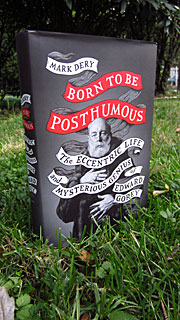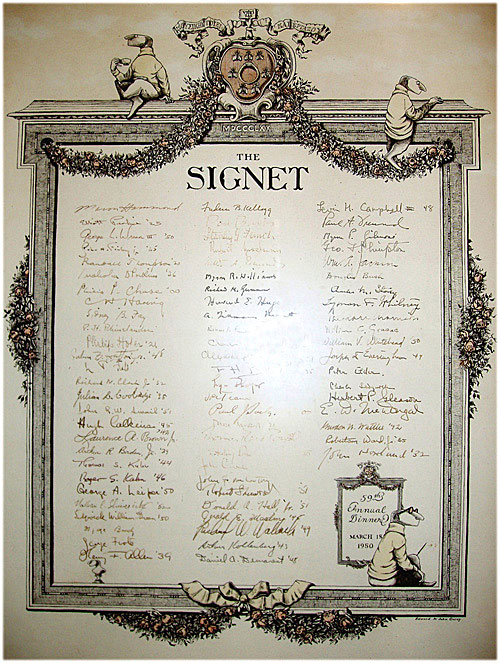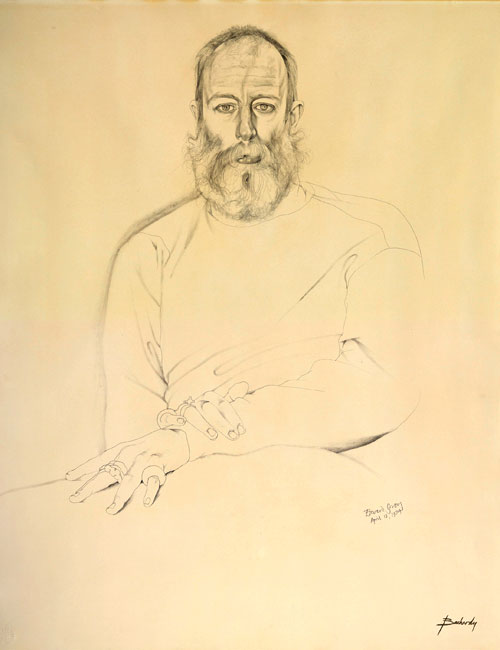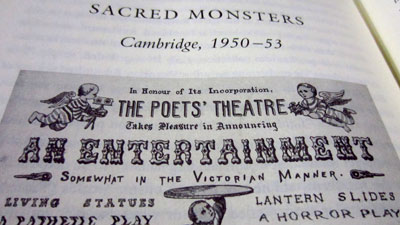Goreyography
Reviews
BORN TO BE
POSTHUMOUS
The Eccentric Life and Mysterious Genius of
Edward Gorey
by
Mark Dery
Reviews
BORN TO BE
POSTHUMOUS
The Eccentric Life and Mysterious Genius of
Edward Gorey
by
Mark Dery

Born to Be Posthumous;
The Eccentric Life and Mysterious Genius of
Edward Gorey
by Mark Dery
Little, Brown & Co., New York
ISBN 978-0316188548
hardcover, 512 pages
$35
available paperless for $16.99
from Little, Brown & Co
The Edward Gorey House,
or from Amazon.com
Reviewed
31 October 2018
by Glen Emil,
Goreyography
|
Here are two things that I enjoy enormously: a really nice glass of Pinot Noir, and an early vintage Edward Gorey, up to about 1980, give or take a book. Either makes me a very happy person. Guaranteed pleasure, it's been going on for years. Is there a connection?
Upon reflection - easy to do with a glass of wine, I get a lot of emotional satisfaction from either. Fully engaged, whilst consuming them, I listen, because they speak to me, they have something to say. Oddly, I find it easier to describe why a favorite wine excites me than I can for a favorite Gorey, like The Epiplectic Bicycle'. In wine, my response to taste and smell forms an emotional connection; for Gorey, the intricate and engaging artwork gives visual pleasure, imagining what takes place between the illustrations - the untold parts of the story, provides curiosity and mystery, and the emotional pleasure unfolds. I can almost hear music as I turn the pages. Both make me smile, deeply, at the finish. Art historians and wine writers are both driven by the same desire, to explain what is special about the objects of their enjoyment, and hopefully create links to the possible factors and influences that inspired their creation. To capture the 'why' for the 'extra special'. 
Cultural critic, pundit and author Mark Dery's latest book Born to be Posthumous (BTBP hereafter) isn't only about Edward Gorey's unique talents in the literary arts but what was happening to and around Gorey at certain points in his life. Using research methodology of a seasoned investigative reporter, Dery creates a detailed and colorful composite sketch of our Mr. Gorey, in his world. The usual suspects are all there, along with a few less familiar names: Harvard icons such as Frank O'Hara and...Tony Smith? Archives of letters with writer Alison Lurie and Bill Brandt from Gorey's Army days fill in a considerable amount of shading and texture, revealing Gorey steeped in personal relationships. Family members Skee and Ken Morton, and close friends like Peter Neumeyer describe Gorey's persona in greater detail. His commitment to ballet and Balanchine's work in particular becomes very clear, illuminating not only Gorey's love of the dance, but also to the social life within this realm, on the streets of Manhattan. Dery's book weaves interviews, letters and events in a way that creates a kind of mental documentary. It's an inspired perspective. It is also from these sources, that BTBP quite quickly introduces the theme of a repressed sexuality in Gorey's existence, running alongside the timeline of his life. The rise of post-Stonewall activism, gay liberation and gender identity politics as one of the driving forces during the 60s and 70s, with Gorey in the thick of it, as were many in his milieu, can't be ignored. Dery links the aesthetic of Camp, to Gorey's outward persona and art, as signposts in gay culture. Perhaps it's what gives Gorey's artwork that certain flamboyance, that so intrigues and entertains in the pages of his most compelling books. Add to that a high degree of Victorian and Edwardian Anglophilic appreciation, of the 'long summer afternoons and garden parties' and we get the picture. You can decide. 
But enough of that, BTBP is a very good read, as people say these days. I enjoyed Dery's narrative, writing style, and the vast quantity of loving detail. I will certainly use BTBP for reference and recreation. Call it a new, '2ndDery Source' [my apologies] in the Gorey-sphere. It does contain a fair amount of speculation about the impact people and events could have had on Gorey's life and art, but it is speculation easily suggested, and in the past in more academic writing, was rarely so directly applied. This is what makes Born to be Posthumous original, and in some 'fresh-air' aspect, welcome. Now, the next thing to do is find out if the combination of my favorite Pinot Noir and favorite Gorey book doubles the pleasure. - Glen Emil, Goreyography 31 x 2018 Happy Hallows' Even'n 
About the Author Mark Dery, born December 24, 1959, is an American author, lecturer and cultural critic. He writes about "media, the visual landscape, fringe trends, and unpopular culture." From 2001 to 2009, he taught media criticism, literary journalism, and the essay in the Department of Journalism at New York University. In January 2000, he was appointed Chancellor's Distinguished Fellow at the University of California, Irvine. In the Summer 2009, he was awarded a scholar-in-residence position at the American Academy in Rome, Italy. In 2010, Publisher's Weekly reported that he was writing a biography of the artist Edward Gorey for Little, Brown. Born to Be Posthumous is the result. Visit his website at www.markdery.com. Many thanks to Jennifer Shaffer of the Hachette Book Group (Little, Brown & Co.) in NY and to Mark Dery |
Book photograph by Goreyography, c 2018